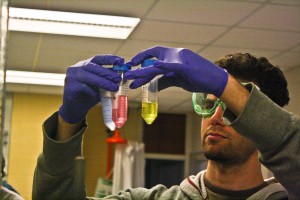Stem cell conference digs in deep

Among the intricate wood carvings and the stained pain glass windows of historic Meadow Brook Hall, over 100 professionals from around the Metro Detroit area gathered at the “Stem Cell Michigan Meeting” to discuss stem cells and recent findings that had been made on the subject.
Jeff Mason, the executive director of Michigan’s University Research Corridor, said the meeting started a loosely organized group of individuals that had interest in stem cells.
The URC is comprised of the University of Michigan, Michigan State and Wayne State. OU is not apart of the URC, but they are working on joining.
Oakland University began their stem cell research in 2002 and partnered with Beaumont Hospital in 2010 to create the Institute for Stem Cell and Regenerative Medicine.
Oakland uses cord blood stem cells, as well as adult stem cells which according to OU Professor and Beaumont Hospital ISCRM Coordinator Rasul Chaudhry are very similar to embryonic stem cells but don’t carry the same social stigma.
Chaudhry said once a child is born, blood remains in the placenta and in the attached umbilical cord. From there, doctors are able to extract the cord blood stem cells.
“(Stem cells) change everything in medicine and has the chance to improve the quality of individuals lives,” Chaudhry said.
Hopeful against diseases
According to Chaudhry, stem cells may offer a solution to people that have Degenerative Disc Disease, which is the gradual deterioration of the disc that is between the vertebrae. Currently DDD has no known cure.
Chaudhry said if they could get stem cells to regenerate the center of the disc which is destroyed by DDD, then there might be something that would provide a cure for the disease.
Stem cells are currently being researched in regard to diseases that are associated with old age and with parts of the human body simply wearing out.
Chaudhry said through stem cells, Beaumont Hospitals has been able to strengthen the muscle that controls the bowels and bladder, thus eliminating or reducing the problem of incontinence, which is a common problem with old age.
The lab at OU has already reproduced neurons, he said, and the hope is that they can eventually replace the neurons in the plane that are effected by Parkinson’s, thus curing the disease.
In addition to these diseases, OU is hoping that stem cell therapy will help multiple sclerosis, Alzheimer’s disease and diabetes.
One major issue facing scientists and doctors when it comes to the use of stem cells is the fear that the body will try to reject the stem cells, said Chaudhry.
“Realistically it will take a long time before we will be able to use stem cells on a particular disease,” Chaudhry said.
They can also aid in the discovery of whether or not a certain medication will lead to the loss of a fertilized embryo.
Embryonic ethical dilemma
Stem cells are not without controversy, however. Embryonic stem cells are researched and created through in vitro fertilization (a way of using sperm to fertilize a woman’s egg in a lab setting).
The student organization Students for Life opposes embryonic stem cell research, but believes adult stem cell research, in which cells from adult organs are studied, is a valuable medical contribution.
“We want to be clear about this distinction- we understand the value of medical research and its healing goals, but not when human embryos are being destroyed to accomplish that,” Jana Duggan, vice president of Student for Life said. “Adult stem cells, on the other hand, can be harvested with no harm to the donor.”
Chaudhry hopes by hosting this conference OU will be looked upon as equals in the eyes of their peers.
“We want to show that this is a place where you can raise a family and have a good job,” Chaudlhy said.
Contact senior reporter Sarah Hunton at [email protected] and Chris Lauritsen at [email protected]







